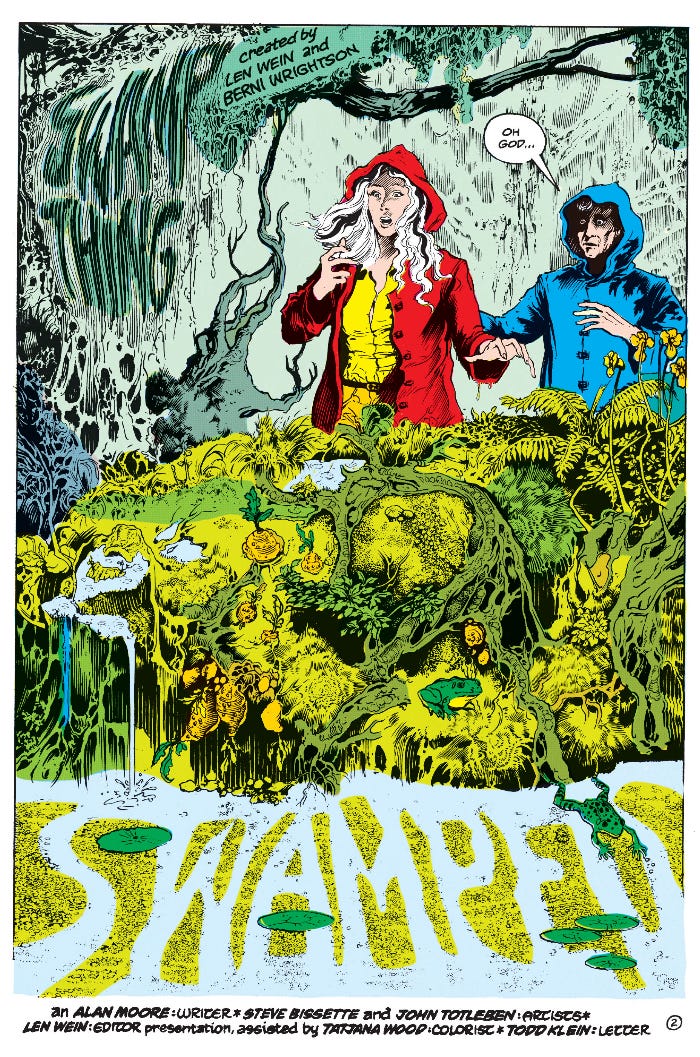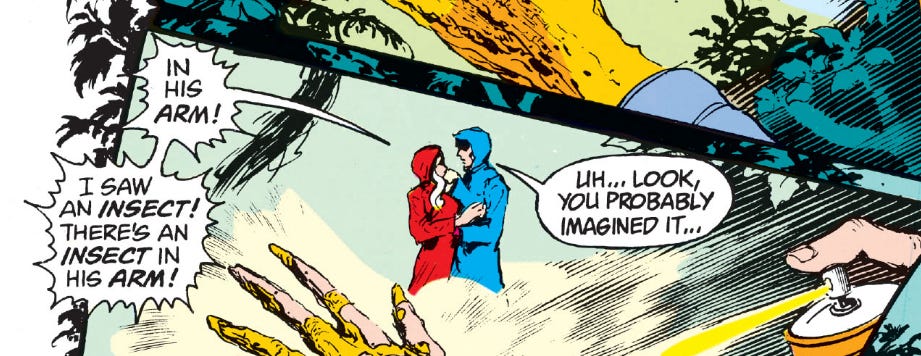“Oh no, Matt, look, he’s rooted! He’s rooted into the Swamp!”
Welcome to The Vertigo Weekly Reader #2.
Last weekend was Thought Bubble, and the launch of my first printed pages of comics in the Joe and His Killer Robot Dad special. It’s a lovely piece of print. More importantly, I had a great evening chewing off Mick McMahon’s ear about video game production and listening to stories about his days sharing a studio with Dave Gibbons behind a dodgy antique shop in the early 80s.
A quick note on programming: I happened to launch this thing on a Thursday, so that’s what we’re sticking with for now. It’ll be one free post a week, with paid content firing up either next week or the week after. Schedule TBC on that front—I’m figuring it out as I go. While I’m taking my time over the first few issues of Moore, Bissette, Totleben et al’s Saga of the Swamp Thing run. I don’t intend for everything to be this close a read, though.
This week, we’re into issue #22, by Alan Moore (writer), Steve Bissette and John Totleben (line art), Tatjana Wood (colourist), Todd Klein (letterer), Len Wein (editor).
Swamp Thing takes root
As we can see in the page above, following the revelation that he’s not, in fact, a man who became a plant, but a plant that believes it’s a man, Not-Alec-Holland has just given the f___ up.
“Just the moss-encrusted echo of a man. Not a man at all,” moons Jason Woodrue, the Floronic Man*.
“He hasn’t moved in a fortnight. He’s put down taproots and stopped pretending to breathe.”
Not-Alec produces an edible yam.
In The Weird and the Eerie, writer/philosopher Mark Fisher characterises the weird as the unsettling intrusion of something into a place where it doesn’t belong, and the eerie as either an absence or as an unanswered question around agency.
[T]he eerie is fundamentally tied up with questions of agency. What kind of agent is acting here? Is there an agent at all? These questions can be posed in a psychoanalytic register — if we are not who we think we are, what are we?
(Capital, Fisher says, is eerie: “Conjured out of nothing, capital nevertheless exerts more influence than any allegedly substantial entity.” We could/should add that generative AI is eerie—it offers a very powerful sense of agency, but it’s utterly hollow.)
The rooting of ‘Alec’ is deeply eerie. It’s the next stage of his disengagement from humanity. Having lost his/its purchase on humanity, he/it goes on to voluntarily give up his/its agency, too.
Water pools in what used to pass as his eye sockets. A sapling pokes out of a nostril.
Woodrue is hella-jealous: “You’re making the change, aren’t you?” he says. “Giving up the illusion of meathood and sinking back into the soft and welcoming green.
“It is breathtaking to observe.
“How I envy you.”
You can see his point. Fisher writes that, unlike the weird, the eerie is often associated with a sense of calm:
The eerie also entails a disengagement from our current attachments. But, with the eerie, this disengagement does not usually have the quality of shock that is typically a feature of the weird. The serenity that is often associated with the eerie - think of the phrase eerie calm - has to do with detachment from the urgencies of the everyday. The perspective of the eerie can give us access to the forces which govern mundane reality but which are ordinarily obscured, just as it can give us access to spaces beyond mundane reality altogether. It is this release from the mundane, this escape from the confines of what is ordinarily taken for reality, which goes some way to account for the peculiar appeal that the eerie possesses.
My Buddhist philosophy is super-rusty, so feel free to correct me in the comments, but The Rooting of the Stump Thing isn’t a million miles away from the end-game of meditation. A peaceful return to the matter of the universe. The subsuming of consciousness into the processes of life.
Except:
To Abby, he’s dead.
Woodrue’s not bothered. He still wants it. And he eats the yam.
But ‘Alec’ still dreams.
And Woodrue, when he gets what he wants, experiences it as overwhelming horror. He connects to what we might anachronistically call the wood-wide web, but his consciousness remains. He can’t switch off.
It looks like our experience of the internet in 2024.
The absence in #21 and #22 of main character energy is one of the surest signs we’ve entered a new era of SotST, aimed at a different audience. When I was a kid I used to hate that shit. Your name’s on the cover, I damn well expect to see you in the comic. Not as a haunting, not through the eyes of another character—up close and extremely bloody personal.
But narratively-othering a character, putting them at a distance from the reader, is an extremely effective way of refreshing them for the audience. By rooting him, Moore is getting to the problem of Swamp Thing (and, more abstractly, many monster comics): how interested are we, really, in a walking plant who mostly just hangs out in the swamp?
And the answer, as with many sub-A-list characters, is it all depends on the take.
I’m into it.
Next time: yep, more Swamp Thing.
*Great name? Yes, great damn name.







